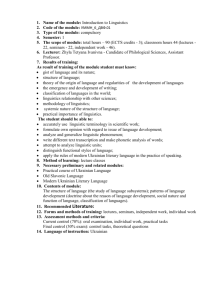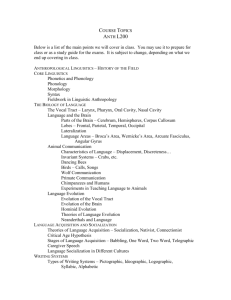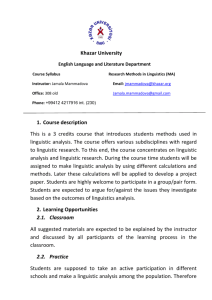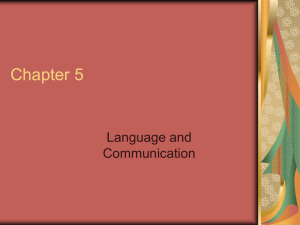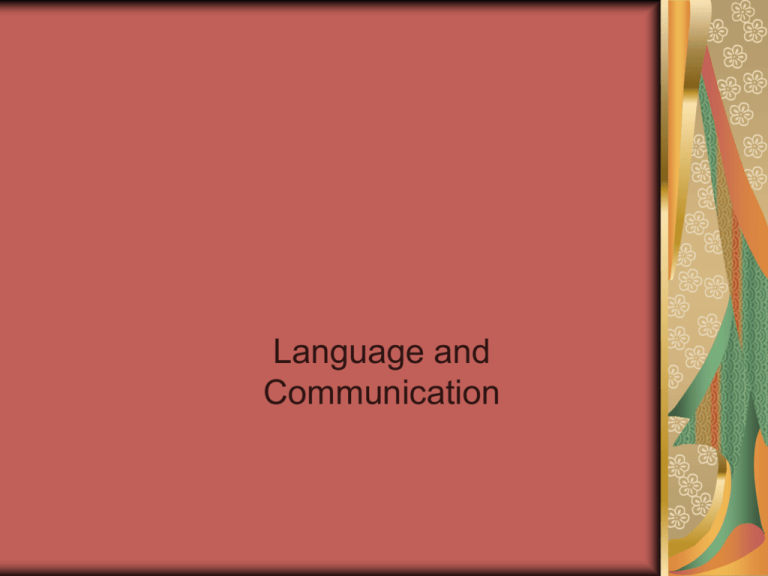
Language and
Communication
Language
Language
Humans’ primary means of communication
Transmitted through learning
Symbolic
Humans can communicate beyond the present
Anthropologists study language in its
social/cultural context
Language Statistics
6912 – number of languages spoken
today
516 – number of almost extinct
languages
Mandarin Chinese – most speakers
Papua New Guinea – country with the
most languages spoken (820)
English – language with the most words
(250, 000)
Properties of language
Multimedia
Discrete
Arbitrary
Productive
Displacement
Note: the most difficult language to learn is
related to your native language.
What Is Language?
How Is Language Related to
Culture?
Without our capacity for complex language, human culture
as we know it could not exist.
Age, gender, and economic status, may influence how
people use language.
Language and Learning
Humans can communicate past and
future
Language is related to culture and
learning
Language and children
How Do Languages Change?
Languages are constantly
transforming— new words are
adopted or coined, others are
dropped, and some shift in meaning.
Linguisitcs
Study of human language
Historical linguistics
Structural linguistics
Historical linguistics uses linguistics to
look at people. In order to do
historical, you must first know
structural
Linguists and Fieldwork
For linguists studying
language in the field,
laptops and recording
devices are
indispensable tools.
Here Tiffany Kershner
of Kansas State
University works with
native Sukwa speakers
in northern Malawi,
Africa.
Descriptive Linguistics
The branch of linguistics that involves
unraveling a language by recording,
describing, and analyzing all of its
features.
Historical Linguistics
Look at three things
Language changes over time
Migration
Diffusion
Glottochronology
Look at languages when dialects split
© 2008 McGraw-Hill Higher
Education. All right reserved.
Glottochronology
Numic Expansion
© 2008 McGraw-Hill Higher
Education. All right reserved.
Structural linguistics
Phonology and Morphology
All languages have units of sound
(phonemes) and units of meaning
(morphemes)
English has 46 phonemes
Morphology
The study of the patterns or rules of
word formation in a language
In linguistics, morphemes are the
smallest units of sound that carry a
meaning.
Cat
Phonology
The study of language sounds.
Phonetic alphabet
© 2008 McGraw-Hill Higher
Education. All right reserved.
Syntax and Grammar
Syntax
In linguistics, the rules or principles of
phrase and sentence making.
Grammar
The entire formal structure of a language
consisting of all observations about the
morphemes and syntax.
The Indo-European languages
English and the Indo-European
Language Family
Linguistic Nationalism
The attempt by ethnic minorities, and
even countries to proclaim
independence by purging their
languages of foreign terms.
Digital Divide
80% of today’s Internet
users are native
speakers of just ten of
the world’s 6,500
languages.
Sociolinguistics
Sociolinguistics – relationships
between social and linguistic variation
Linguistic diversity
Nation states
Gender speech contrasts
Stratification and symbolic domination
Black English Vernacular (BEV)
All people style shift – vary their speech
in different social contexts (Diglossia)
Gendered Speech
Makers of the film Dances with Wolves hired a language
coach to teach Lakota to the actors who did not know how to
speak it.
The lessons did not include the “gendered speech” aspect of
Lakota.
When Lakota speakers saw the finished film, they were
amused to hear the actors who portrayed Lakota warriors
speaking like women.
Dialects
Varying forms of a language that
reflect particular regions or social
classes and that are similar enough to
be mutually intelligible.
Code switching - The process of
changing from one language or dialect to
another.
Ethnolinguistics
The study of the relation between
language and culture.
Linguistic relativity
Language, thought, and culture
Language, culture, and thought are interrelated
Changes in culture produce changes in
language and thought
Cultural contrasts and changes affect lexical
distinctions (e.g., peach vs. salmon) within
semantic domains (e.g., color terminology)
Semantics – a language’s meaning system
Lexical contrasts that people perceive as
meaningful or significant reflect their
experiences
Noam Chomsky
Universal grammar
All languages have a
common structural
basis
All humans have similar
linguistic abilities and
thought processes
Linguistic Determinism
The idea that language to some
extent shapes the way in which we
view and think about the world around
us.
Sometimes called the Sapir-Whorf
hypothesis after its originators
Edward Sapir and his student
Benjamin Lee Whorf.
Linguistic Determinism and the
Aymara Indians
Aymara Indians living in the highlands of Bolivia and Peru in
South America depend on the potato as their major source of
food.
Their language has over 200 words for this vegetable,
reflecting the many varieties they grow and the different ways
they preserve and prepare it.
Sapir-Whorf hypothesis
Language controls culture
Language shapes—but does not
restrict—thought
However, cultural changes can
produce changes in thought and
language (contrary to Sapir-Whorf)
Focal vocabulary
Lexicon (vocabulary) influences
perception
Vocabulary is the area of language
that changes most readily
Nonverbal communication
Kinesics – study of
communication
through body
movements,
stances, gestures,
and facial
expressions
Gestures, facial
expressions, and
body stances are
shaped by culture
Learned Gestures
The “Hook ‘em,
horns”salute flashed by
U.S. President Bush
and his family during his
2005 inauguration
shocked many
Europeans who
interpreted it as a salute
to Satan.
Other Types of Language
Paralanguage
Tonal Language
Origin of Language: One Theory
Early hominids, began using gestures to
communicate intentions within a social
setting.
When Homo erectus moved out of the
tropics, they needed to plan and
communicate to survive seasons of cold
temperatures.
By the time archaic Homo sapiens
appeared, finely controlled movements of
the mouth and throat had given rise to
spoken language.
Biology and Human Speech
Gesture-Call System
Inherited from our primate ancestors.
Gesture component consists of body
motions used to convey messages.
Call component consists of
extralinguistic noises involving various
voice qualities and vocalizations.
Call systems
Sign Language
Apes and Sign Language
Several species of apes
have been taught to use
American Sign
Language.
Some chimpanzees
have acquired signing
vocabularies surpassing
400 words, and a
lowland gorilla named
Koko has a working
vocabulary of more than
1,000 words.
Language and Symbols
Tee Yee Neen Ho Ga Row,
Mohawk chief of the Iroquois
Confederacy, holding a
wampum belt of hemp string
and shell beads.
Wampum designs were used
to symbolize a variety of
important messages or
agreements, including
treaties with other nations.
(By Dutch painter Johannes
Verelst in 1710. National
Archives of Canada
collections.)
Writing System
A set of visible or tactile signs used to
represent units of language in a
systematic way.
An alphabet is a series of symbols
representing the sounds of a
language arranged in a traditional
order.





